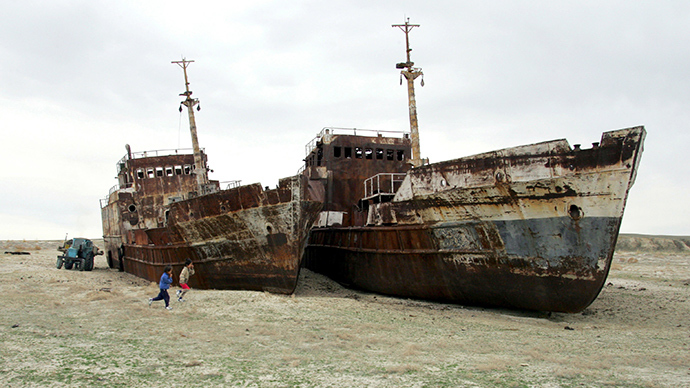
1. The journey begins back in 1972, when the first images of the shrinking Aral Sea were taken by a Landsat satellite. A time-lapse of Asia reveals that many of the lake's areas were completely dry by 2009.
2. The ambitious Soviet project - a diversion of the two rivers that fed into the Aral Sea - was only a short-term success. The engineers decided that the Amu Darya and Syr Darya rivers would irrigate the desert, where cotton could be grown for future exports - but the implementation of the idea led to an ecological catastrophe.
3. Imagine yourself traveling from the small Kazakh city of Aralsk to the Aral Sea, which is slowly and steadily dying. Having turned into desert, it is now home to camels and abandoned ships decorated with graffiti depicting the ghosts of sailors.
4. One of the world's worst man-made environmental disasters, the Aral Sea was once the size of Ireland. RT's Lindsay France went to Kazakhstan to report on the ambitious attempts to rejuvenate the sea with the help of dams.
5. The Aral Sea's demise also puts the health of people living on its shores at risk. "You can't see salt in the air, but you feel it on the skin, and you can feel it on a tongue," said a local woman, whose husband suffers from chronic bronchitis. But the salt isn't the only threat; the wind also spreads dangerous pesticides.
6. Scientific forecasts have long been claiming that the Aral Sea is beyond salvation and will die within a decade. However, with the water flowing back, there are hopes for Aralsk - which was once a port city - and its economy.
7. The water level is growing, and fish are returning to the Aral Sea - which was once home to the region's prosperous fishing industry. "They brought the sea back to us," a local fisherman told RT's Lindsay France.
8. According to explorer and adventurer George Kourounis, who visited parts of the 'ghost' Aral Sea, "the brisk trade and friendly used bucks belie the intense hardship that comes when your livelihood literally evaporates."
9. Recent photos taken by NASA's Terra satellite reveal the scale of the Aral Sea's drought over the past 14 years, starting in 2000. The eastern basin of the Southern Sea, one of the two parts of the Aral, has dried up for the first time in an estimated 600 years.
10. Rescue efforts include more than just mere discussion, as vegetation has been planted in the exposed seabed. However, many projects are at stake due to a lack of funds or political will.



Reader Comments
to our Newsletter